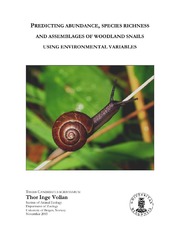Predicting abundance, species richness and assemblages of woodland snails using environmental variables
Master thesis
Permanent lenke
http://hdl.handle.net/1956/1533Utgivelsesdato
2003Metadata
Vis full innførselSamlinger
Sammendrag
The abundance and diversity of woodland snails (Gastropoda: Pulmonata) were investigated in a large-scale study in Geitaknottane Nature Reserve in Kvam County (Norway). Snails were collected in 132 squares (50 X 50 meters) in an area of approximately 1,5 km2. Six sifting samples (1-3 liters) were taken from the litter in each square, and environmental variables were also recorded. Detrended correspondence analysis (DCA) and canonical correspondence analysis (CCA) were applied to relate the relative abundance and diversity of snails to the most important environmental variables measured. A total of 11478 individuals in 30 species from 12 families were found in the area. The range of snail species was from 2 to 22 per square, and the number of individuals per square ranged from 1 to 788. The significant environmental variables considered were productivity, aspect, gorge, cliff area, mire, scree area, pollarded trees, topographic position, vegetation type and number of dry calcium-indicating moss species. The main axes in CCA were interpreted as representing richness of nutrients (axis 1) and humidity (axis 2). These axes explain respectively 62% and 12% of the speciesenvironment relation in the analyses. Several groups of species was indicated by ordination, and by interpreting these groups placement in the ordination diagrams several predictions about optimal habitats and environmental tolerance were made. Keywords: Land snails, biodiversity, abundance, forest, prediction, multivariate analysis, Norway.
Utgiver
The University of BergenOpphavsrett
The authorCopyright the author. All rights reserved
